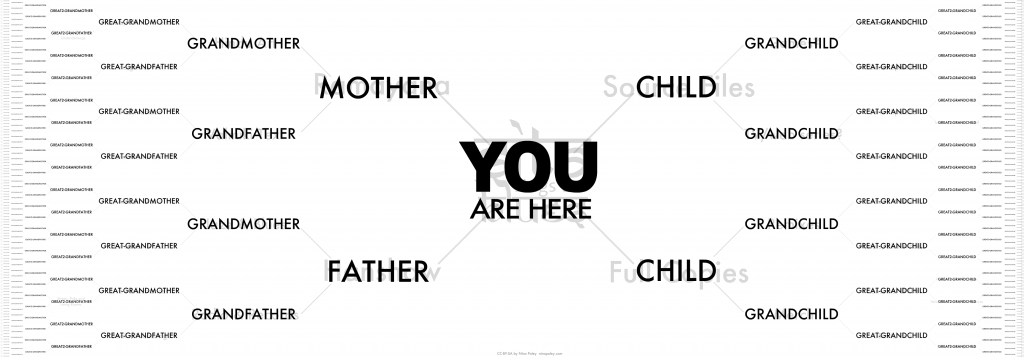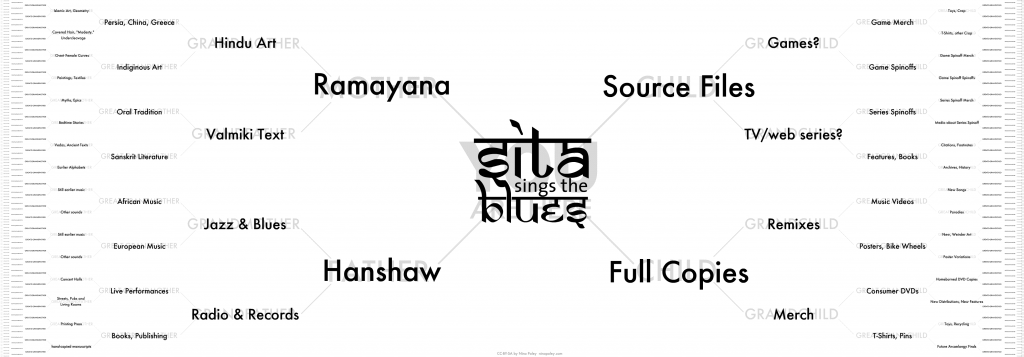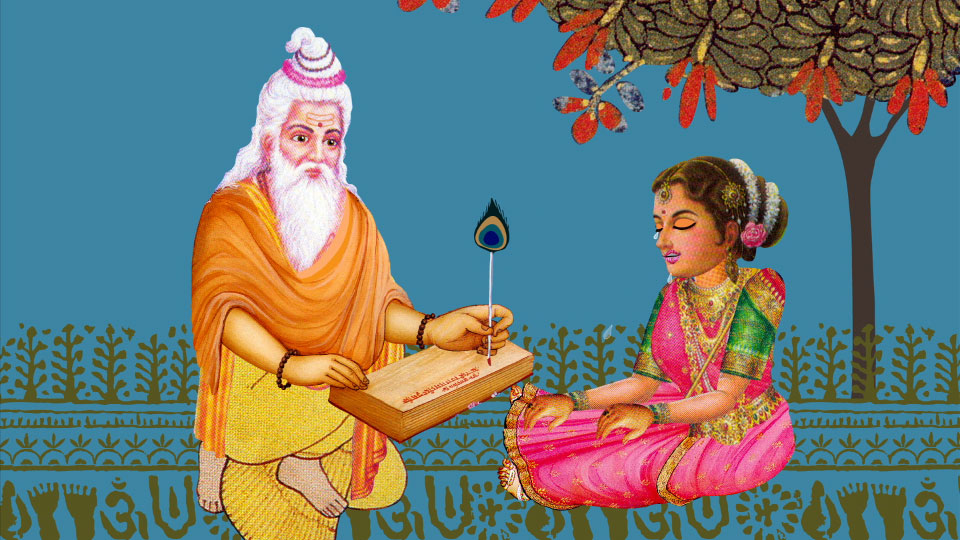I’ve updated the pedigree charts I posted a few days back.
Although I use an attribution copyleft license (CC-BY-SA), I recognize that expecting attribution for every re-use is a bit unrealistic. Sure, it’s reasonable for the first few generations: most people can name their mother and father, and many can name all 4 grandparents. But expecting them to name all 8 great-grandparents is a little much. Who knows the names of all 16 of their great-great-grandparents, or all 32 great-great-great-grandparents? And so on.

Likewise, I expect people to cite Sita as a source in the first few generations of remixes. I don’t think I need to legally coerce people to name me as the source author, any more than legal coercion is needed for most people to name their parents. Or grandparents; a remixed remix can still cite this source. But a remixed remix of a remixed remix? How much “Sita” is even left at that point?

Sure, I’d like to be credited in works containing 1/144th dilutions of Sita, but is that reasonable?
Here the analogy between memes and genes weakens, because memes don’t recombine sexually like genes do. Making Sita’s “memeology” match the biological pedigree chart was awkward; cultural works can have many more than two “parents” for every “child.” I had to omit many of Sita’s other “parents,” like 2-D animation (cut-out animation, Flash, computer science, Fleischer Bros., Eduard Muybridge, etc.), to make the charts match. With all those “parents” mixing willy-nilly into all those “children,” dilution of attribution could happen in even fewer generations.
Take this still from Sita Sings the Blues:

It’s a collage made up of more than 15 disparate elements. Just the pattern in the background is comprised of 3 different traditional textile print designs. The border with the little feet and om symbols is obviously made up of many other elements, combined long before it ever reached my eyes. The tree comes from a reproduction I scanned from a book (lost in the Great Bedbug Infestation of 2008, so I couldn’t find it even if I wanted to); it comes from a painting, which may have been almost identical to many other paintings of its time, depending on whether it was produced in a big workshop. Surely it borrowed techniques from earlier paintings, which were based on earlier paintings….And that’s not even addressing the bits that make up Valmiki and Sita in the foreground, which were taken from more sources than I can recall.
I did “paint” the peacock feather by my own hand, so that’s “original.” Except the idea comes from dozens of paintings of Valmiki transcribing the Ramayana, and calling a peacock feather “original” because it wasn’t collaged in from another image, is just stupid.
My point is, even though attribution is important, it has its limits, which hopefully you can see in the illustrations above.

This is one reason why the legal form of the Creative Commons “Attribution” module has drawn some criticism. Clearly, a “full” attribution list will get quite unweildy very fast for a heavily-remixed work — even if we limit ourselves to works which clearly are “derivatives” and not “fair use.”
Consider also, the impact on large collaborations like films: if use a short clip from “Sita”, must we roll the entire titles to satisfy “By”? Or is it enough to just say “from Nina Paley’s film, ‘Sita Sings the Blues'”, etc.? — the legal language is a little ambiguous about how much you can insist on, and it’s pretty vague on exactly how you’re supposed to communicate that information. (Also note that this is theoretically not entirely up to you — any By-SA material you incorporated has the right to insist on attribution terms being shared-alike by your release).
Something like that was ironically the “big problem” with the BSD license — it had an “advertising clause” which was really just a kind of “attribution” requirement, which made it legally incompatible with the GPL.
In practice, most By-SA works to date are not very “deep” in remixing, and it hasn’t been that much of a problem (people usually aren’t too fussy about attribution, as long as you do _something_). But it might become a problem in the future.
That’s why I always like to include an explicit “preferred form of attribution” whenever I release something under By-SA (you can see examples in some of my columns). When Blender released their Open Movies, they stated that the credits should be rolled in any showing or complete copy, and that excerpts should attribute to “Blender Foundation | http://www.blender.org“.
There’s actually lots of these piddling details with copyleft licenses that sometimes make them incompatible. That’s why I think that copyleft terms should expire after some period of time (following the same reasoning as for copyright itself — so the work is easier to reuse).
Not to quibble, but it does your excellent argument no good to get the numbers so far off. Biologically, at least you have only 8 great-grandparents, 16 great-great-grandparents and so on by powers of two.
D’OH! Thanks Kahomono – I just corrected it. Fortunately, as you can see, the quantities are all correct in the illustration, proving that my right brain knows what my dysnumeric left brain screws up.
Hey nina
I pretty much think this is quite a kickass, and as accurate a version of ramayan as any other that I’ve been trained to ingest since childhood.
Groovy.
http://sanneb.deviantart.com/art/Cyclops-Demon-Snake-156773803
I was inspired by the flying cyclops snake demons and modified them.
Enjoy!
Nina Paley must do the right thing by withdrawing this ‘Sita’s Blues’ from further publication of any kind.
It is offensive to say the least, to billions of Hindus who study and understand the Ramayana …
Distorting Hindu epics, insulting and hurting the sentiments of others is neither art nor intelligence…
The “problem” with the names, if it really is a problem, will not go on forever. Copyright lasts extremely long, but it doesn’t last forever. That is also true for Creative Commons licenses. 70 years after your death nobody has to mention you anymore.
Don’t get me wrong. I wish you a long life and that you’ll never fall into oblivion. 😉
I love your work and wonder if you might want to be on a panel to talk about ‘creative financing’ in nyc in June. Thank you.